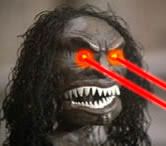
The camel spider recently received his fifteen minutes of fame because of this photo on the right. Yeah, it's a damn big, creepy-crawly thingy, no two ways about it. And what did my class "know" about the camel spider?
1. It can be as big as a garbage can lid when its legs are extended.
2. It can jump three feet vertically in the air.
3. It can run 25 miles per hour.
4. It lives in and feeds off the stomachs of camels, hence its name.
5. It has a novacaine-like sting that keeps you from noticing it's slowly taking big chunks out of your flesh.
6. It runs alongside military vehicles in Iraq, making a screaming noise as it chases them.
 Scary, huh? From the sound of it, these things make the facehuggers in Alien seem like Monchhichis in comparison. But how much of what my class is so sure of is really true? Well...
Scary, huh? From the sound of it, these things make the facehuggers in Alien seem like Monchhichis in comparison. But how much of what my class is so sure of is really true? Well...1. It's a big SOB, but it doesn't get as large as a garbage can lid. A frisbee MAYBE...
2. Much like white men, camel spiders can't jump.
3. It runs about ten miles an hour. So it could probably keep pace with a man, but it's Michael Johnson is safe.
4. It's called a camel spider because it lives in the desert, not because it lives inside or feeds on camels.
5. Not venomous. In fact, they aren't generally dangerous to humans, preferring to eat insects and maybe the occasional lizard or very small bird. Camel spiders actual aren't even spiders; they're of the order Solifugae, which makes them arachnids, but not true spiders.
6. The reason that some folks have accused them of being aggressive is because they're nocturnal creatures, preferring to stay out of the hot desert sun, and so when humans or other creatures are around, they try to get in your SHADOW for shade (this may be where the camel stomach rumor came from; perhaps they tend to sit under a camel's abdomen to keep cool).
So where do the rumors come from? Well, as you can see in the somewhat infamous photo above, and a number of the camel spider videos on YouTube, our soldiers in Iraq have been encountering these thingies since they've been over there. If I may do a bit of urban legend psychoanalysis here (like the "king" of urban legends, Jan Harold Brunvand, who I was lucky enough to correspond with for a while many years ago), I would suggest that it stems from our fears (A) for our troops in a strange foreign land, and (B) our own sense of xenophobia about "those people" and "that place" over there. It's a hard thing to think of our own sons and daughters over there in harm's way, and even harder to think about them killing and being killed by other human beings. And I think perhaps we express all that fear and uncertainty by creating an even more alien enemy and landscape in our minds. Hence things like the camel spider.
The thing is, the camel spider is not even a middle eastern phenomenon. They exist is most of the world's desert in one form or another, including the southwestern part of the United States. In other places they might be called the wind scorpion or sun spider, but when we talk about them, they tend to be the camel spider, because what's more middle eastern in the collective consciousness of the United States than a camel?
So when it comes down to it, if the camel spider is a monster, it's mainly a monster created by our subconscious, and our psycho-sociological need to create scapegoats and cautionary tales.
Also, it's one big, scary freakin' bug...







5 comments:
I remember first seeing this one back in the 90s during the first Gulf War. Pretty easy to spot it isn't real - Spiders simply don't get that big, and the only ones that come close are in the tarantula family, which our friend the Camel Spider clearly isn't.
However, I love that someone suggested they aren't really spiders, just realated to them (you know, like crabs and lobsters). Hilarious.
Not sure what you're saying there, Jeremy, as they're NOT spiders.
This quote explains that pic and others like it, though:
"The camel spider's history of misinformation begins with a misidentification. Camel spiders are not even spiders. Like spiders, they are members of the class Arachnida, but they are actually solpugids.
Camel spiders, also called wind scorpions and Egyptian giant solpugids (SAHL-pyoo-jids), are only about 6 inches (15 centimeters) long. Photos that purport to show creatures six times that size have misleading perspective—the spider is invariably placed in the foreground where the lens makes it appear much bigger than its actual size. True, they are fast, but only compared to other arachnids. Their top speed is estimated at 10 miles (16 kilometers) per hour."
Based on the way its abdomen looks, it appears to be a big termite. A big termite that runs 10mph...
And eats lizards...
I love the fact that google ads gives us all the opportunity to shop for Camel Spiders at Yahoo shopping thanks to this blog entry. :P I can't imagine anything I'd want more than my own Camel Spider.
Post a Comment